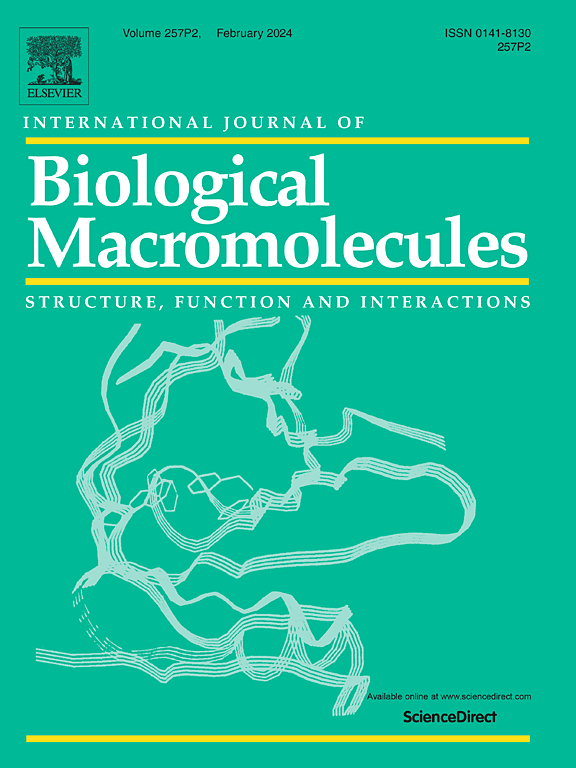一种多组分、多功能、释放药物的cu掺杂Fe3O4/生物活性玻璃/壳聚糖涂层,应用于不锈钢生物医学基底
IF 8.5
1区 化学
Q1 BIOCHEMISTRY & MOLECULAR BIOLOGY
International Journal of Biological Macromolecules
Pub Date : 2025-04-22
DOI:10.1016/j.ijbiomac.2025.143296
引用次数: 0
摘要
采用电泳沉积的方法在AISI 316L不锈钢表面制备了一种药物释放型掺铜Fe3O4/生物活性玻璃58S/壳聚糖涂层,以改善其生物医学性能。利用x射线衍射(XRD)、傅里叶变换红外光谱(FTIR)、场发射扫描电镜(FE-SEM)和能量色散x射线能谱(EDS)对涂层的结构和形貌进行了表征,证实了复合材料成分的均匀性和有效整合。用振动样品磁强计(VSM)评价其磁性能。接触角测量显示表面润湿性增强,而激光轮廓测量证实表面形貌优化。通过紫外可见分光光度法分析药物释放动力学,揭示阿米卡星的缓释。在模拟体液(SBF)中评估生物活性,用电感耦合等离子体质谱(ICP-MS)和SEM-EDS分析证实在表面形成羟基磷灰石。使用MTT法对MG63细胞进行细胞相容性评估,显示出符合ISO 10993-5标准的高活力。抗菌活性,通过菌落计数和琼脂盘扩散试验量化,显示出对金黄色葡萄球菌和大肠杆菌的显著抑制作用。这种提出的复合涂层解决了生物医学植入物的关键挑战,包括生物活性差、细菌定植和不受控制的药物释放。缓释cu掺杂Fe₃O₄/生物活性玻璃/壳聚糖涂层似乎是一种很有前途的易于应用的骨科/生物医学涂层。本文章由计算机程序翻译,如有差异,请以英文原文为准。

A promising multi-component, multi-functional, drug-releasing Cu-doped Fe3O4/bioactive glass/Chitosan coating, applied on stainless steel substrate for biomedical applications
A drug-releasing Cu-doped Fe3O4/bioactive glass 58S/chitosan coating was deposited on AISI 316L stainless steel via electrophoretic deposition, aiming to improve biomedical properties of the surface. The structure and morphology of coating layers were characterized by X-ray diffraction (XRD), Fourier-transform infrared spectroscopy (FTIR), field-emission scanning electron microscopy (FE-SEM), and energy-dispersive X-ray spectroscopy (EDS), confirming homogeneity and effective integration of the composite constituents. Magnetic properties were evaluated using vibrating sample magnetometry (VSM). Contact angle measurements demonstrated enhanced surface wettability, while laser profilometry confirmed surface topography optimization. Drug release kinetics were analyzed via UV–Vis spectrophotometry, revealing sustained release of amikacin. Bioactivity was assessed in simulated body fluid (SBF), with inductively coupled plasma mass spectrometry (ICP-MS) and SEM-EDS analyses confirming hydroxyapatite formation on the surface. Cytocompatibility was evaluated using MTT assays on MG63 cells, showing high viability in accordance with ISO 10993-5 standards. Antibacterial activity, quantified via colony count and the agar disk diffusion assays, demonstrated significant inhibition against Staphylococcus aureus and Escherichia coli. This proposed composite coating addresses critical challenges in biomedical implants, including poor bioactivity, bacterial colonization, and uncontrolled drug release. Drug-releasing Cu-doped Fe₃O₄/bioactive glass/chitosan coating appears to be a promising easy-to-apply coating orthopedic/biomedical applications.
求助全文
通过发布文献求助,成功后即可免费获取论文全文。
去求助
来源期刊
CiteScore
13.70
自引率
9.80%
发文量
2728
审稿时长
64 days
期刊介绍:
The International Journal of Biological Macromolecules is a well-established international journal dedicated to research on the chemical and biological aspects of natural macromolecules. Focusing on proteins, macromolecular carbohydrates, glycoproteins, proteoglycans, lignins, biological poly-acids, and nucleic acids, the journal presents the latest findings in molecular structure, properties, biological activities, interactions, modifications, and functional properties. Papers must offer new and novel insights, encompassing related model systems, structural conformational studies, theoretical developments, and analytical techniques. Each paper is required to primarily focus on at least one named biological macromolecule, reflected in the title, abstract, and text.

 求助内容:
求助内容: 应助结果提醒方式:
应助结果提醒方式:


